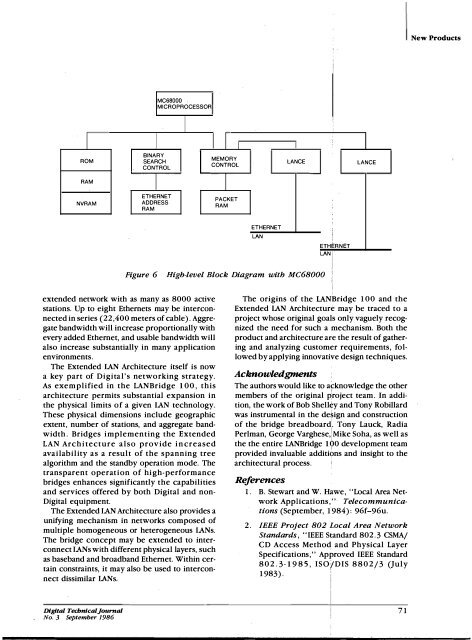New ProductsIMC6BOOOMICROPROCESSORII IBINARYROMMEMORYSEARCH LANCE LANCECONTROLCONTROLRAMNVRAMETHERNETADDRESSRAMIPACKETRAMFigure 6extended network with as many as 8000 activestations. Up to eight Ethernets may be interconnectedin series (22,400 meters of cable) . Aggregatebandwidth will increase proportionally withevery added Ethernet, and usable bandwidth willalso increase substantially in many applicationenvironments.The Extended IAN Architecture itself is nowa key part of <strong>Digital</strong>'s networking strategy.As exemplified in the LANBridge 100, thisarchitecture permits substantial expansion inthe physical limits of a given IAN technology.These physical dimensions include geographicextent, number of stations, and aggregate bandwidth.Bridges implementing the ExtendedLAN Architecture also provide increasedavailability as a result of the spanning treealgorithm and the standby operation mode. Thetransparent operation of high-performancebridges enhances significantly the capabilitiesand services offered by both <strong>Digital</strong> and non<strong>Digital</strong> equipment.The Extended IAN Architecture also provides aunifying mechanism in networks composed ofmultiple homogeneous or heterogeneous IANs.The bridge concept may be extended to interconnectIANs with different physical layers, suchas baseband and broadband Ethernet. Within certainconstraints, it may also be used to interconnectdissimilar IANs.ETHERNETLAN'riETH E RNETLANHigh-level Block Diagram with MC68000 jIiThe origins of the LANBridge 100 and theExtended IAN Architecture may be traced to aproject whose original goals only vaguely recognizedthe need for such a mechanism. Both theproduct and architecture are the result of gatheringand analyzing customer requirements, followedby applying innovative design techniques.AcknowledgmentsThe authors would like to acknowledge the othermembers of the original p;roject team. In addition,the work of Bob Shelley and Tony Robillardwas instrumental in the deign and constructionof the bridge breadboard. Tony Lauck, RadiaPerlman, George Varghese, ! Mike Soha, as well asthe the entire LANBridge 1 00 development teamIprovided invaluable additions and insight to thearchitectural process.References1. B. Stewart and W. Hawe, "Local Area NetworkApplications," Telecommunications(<strong>September</strong>, 1984): 96f-96u.2. IEEE Project 802 Local Area NetworkStandards , "IEEE Standard 802.3 CSMA/CD Access Method and Physical LayerSpecifications," Approved IEEE Standard802.3-1985, ISO/DIS 8802/3 (July'1983).'IDtgttal TecbntcalJournalNo. 3 <strong>September</strong> 198671
The Extended Local Area Network Architecture and LANBridge 1003. W. Bux, "Local-Area Subnetworks: A Per- Open System Interconnection (DecemformanceComparison," IEEE Transac- ber 1983): 1388-1393.tions on Communications, COM-2914. W. Hawe and G. Varghese, "Extended(10) (October 1981): 1465-1473.Local Area Network Management Princi-4. W. Hawe and M. Marathe, "Predicting Eth- pies," <strong>Digital</strong> Equipment Corporationernet Capacity-A Case Study, " Proceed- technical paper ,submitted to IEEE 802ings of the Eighteenth Computer Perfo r-Standards Committee, IEEE Documentmance Evaluation Users Group Con- <strong>Number</strong> IEEE-802.85.1.98 (October 31,ference (October 1982): 375-388. 1984).5. IEEE Project 802 Local Area Network 15. R. Perlman, "An Algorithm for DistributedStandards , "IEEE Standard 802.4 TokenComputations of a Spanning Tree in anPassing Bus Access Method and PhysicalExtended LAN ," <strong>Digital</strong> Equipment Cor-Layer Specifications," Approved IEEEporation technical paper submitted toStandard 802.4-1985, ISO/DIS 8802/4IEEE 802 Standards Committee, IEEE Doc-(December 1985).ument <strong>Number</strong> IEEE-802.85.1.97 (October31, 1984).6. IEEE Project 802 Local Area NetworkStandards , "IEEE Standard 802.5 Token16. R. Jain and R. Turner, "Workload CharacterizationUsing Image Accounting," Pro-Ring Access Method and Physical Layerceedings of the Eigteenth Computer Per-Specifications,'' Approved IEEE Standardfo rmance Evaluation Users Group Con-802.5-1985, ISO/DIS 8802/5 (Decemberference (October 1982): 111-120.1985).17. The Ethernet: A Local Area Network,7. B. Stewart, W. Hawe, and A. Kirby, "LocalData Link Layer and Physical LayerArea Network Connection,'' Telecommu-Specification, Version 2. 0 (<strong>Digital</strong> EquipmentCorporation, Intel Corporation, andnications (April 1984): 54-66.8. W. Hawe, A. Kirby, and B. Stewart, "Trans- Xerox Corporation, Order No. AA-K759BparentInterconnection of Local Networks TK, November 1982).with Bridges,'' journal of Telecommuni-18. R.M. Metcalf and D.R. Boggs, "Ethernet:cations Networks , vol. 3, no. 2 (Summer,Distributed Packet Switching for Local1984): 116-130.:. ,,Computer Networks," Communications9. W. Hawe, A. Kirby, and A. Utuck, "An of the ACM, vol. 19 Ouly 1976): 395-Architecture for Transparently Intercon- 403.necting IEEE 802 Local Area Networks,"19. R. Jain and · Hawe, ''Performance Analy-<strong>Digital</strong> Equipment Corporation technicalsis and Modeling of <strong>Digital</strong>'s Networkingpaper submitted to IEEE 802 StandardsArchitecture," <strong>Digital</strong> <strong>Technical</strong>journalCommittee, IEEE Document <strong>Number</strong>(<strong>September</strong> 1986, this issue) : 25-34.IEEE-802.85.1 .96 (October 31, 1984).20. M. Gerla and L. Kleinrock, "Flow Control:10. B. Mann, C. Strutt, and M. Kempf, "Termi-A Comparative Survey," IEEE Transacworks,"<strong>Digital</strong> <strong>Technical</strong> journal (Sep-nal Servers on Ethernet Local Area Nettionson Communications, vol. COMtember1986, this issue) : 73-87.28, no. 4 (1980): 553-574.21. R. Jain and S. Routhier, "Packet Trains:11. DNA Phase IV Routing Layer Specifica-Measurements and a New Model for Comtion,Version 2. 0. 0, (Maynard: <strong>Digital</strong>puter Network Traffic," IEEE journal onEquipment Corporation, Order No. AA-Sp ecial Areas in CommunicationsX435A-TK, 1982).(Forthcoming, <strong>September</strong> 1986) .12. Internet Transport Protocols (Rochester:22. F. Tobagi and V. Hunt, "Performance:Xerox Corporation, Order No. XSIS.Analysis of Carrier Sense Multiple Access028112, 1981).with Collision Detection," Computer13. R. Call on, "Internetwork Protocol," Pro- Networks , vol. 4, no. 5 (OctoberjNovemceedingsof the IEEE, Special Issue on ber 1980): 245-259.72 <strong>Digital</strong> TecbntcalJournalNo. 3 <strong>September</strong> 1986









